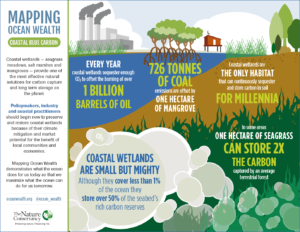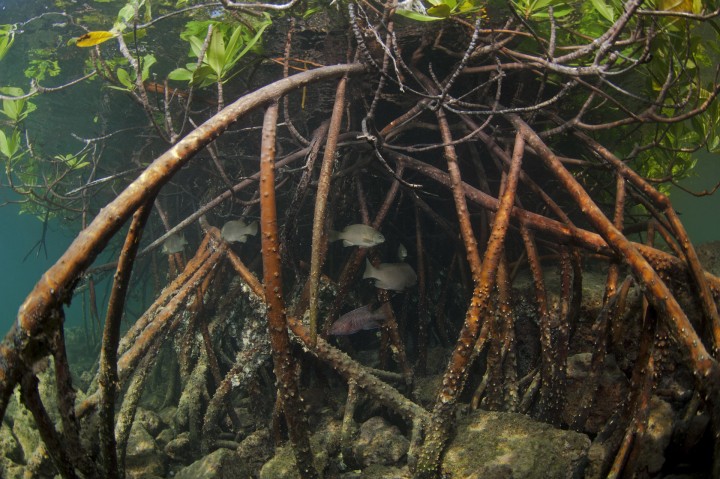Contributed by Emily Landis of The Nature Conservancy
 Last month, governments, intergovernmental organizations, UN agencies, NGOs and civil society convened at the Conference of the Parties (COP) of the United Nations Framework Convention on Climate Change (UNFCCC) to work towards a new global climate change agreement. There, world leaders recognized the need to take strong action to avoid a temperature increase above 2 degrees C, which is the accepted ‘point of no return.’ To avoid the increase, greenhouse gas emissions (GHG) will need to be reduced by 40-70% by 2050. With such an enormous challenge ahead for all countries, how can a small habitat like coastal wetlands play a big role?
Last month, governments, intergovernmental organizations, UN agencies, NGOs and civil society convened at the Conference of the Parties (COP) of the United Nations Framework Convention on Climate Change (UNFCCC) to work towards a new global climate change agreement. There, world leaders recognized the need to take strong action to avoid a temperature increase above 2 degrees C, which is the accepted ‘point of no return.’ To avoid the increase, greenhouse gas emissions (GHG) will need to be reduced by 40-70% by 2050. With such an enormous challenge ahead for all countries, how can a small habitat like coastal wetlands play a big role?
Coastal wetlands are extremely efficient at sequestering and storing carbon where it remains in soils for millennia. These coastal systems, specifically mangroves, salt marshes and seagrass meadows, are referred to as ‘blue carbon.’ Per hectare coastal wetlands sequester and store huge amounts of carbon. Each year, blue carbon systems sequester enough carbon to offset the annual emissions of Thailand. Our new carbon counter was on display at the UN Climate Conference in Paris (COP21). It continues counting up the tremendous volumes of carbon dioxide being locked up every day by blue carbon since the start of the COP21 meeting. However, blue carbon systems are being lost at an alarming rate due to conversion for aquaculture, coastal development and numerous other land uses. This degradation can result in the emission of these blue carbon stores into the ocean and atmosphere.
Current rates of loss of these ecosystems are estimated to be between 0.7–7% of their global area per year, resulting in estimated emissions equal to the annual fossil fuel emissions of the United Kingdom. Although the combined global area of mangroves, tidal marshes and seagrass meadows equates to only 2–6% of the total area of tropical forest, degradation of these systems accounts for 3–19% of carbon emissions from global deforestation.
Coastal wetlands have been the focus of conservation and restoration efforts for over a century with the goal of preserving biodiversity and generating benefits to local communities. With the recognition for their carbon storage and sequestration value, and conversely the emissions released when these ecosystems are degraded or destroyed, doors are being opened for wetland managers to explore funding sources directed towards climate mitigating efforts. Yet many countries are unaware of the options or opportunities that blue carbon can play.
A new report by TNC and partners, “Coastal “blue” carbon: A revised guide supporting coastal wetland programs and projects using climate finance and other financial mechanisms.” emphasizes finance avenues which can link and complement carbon activities with non-carbon based sources for financing coastal and marine restoration and conservation, such as payments for ecosystem services, the use of insurance schemes or debt-for-nature swaps.
If mangroves are included in a country’s definition of a forest, they are eligible under Reducing Emissions from Deforestation and Forest Degradation (REDD) for climate credits. REDD is unlikely to be expanded, however, a country can always voluntarily decide to include other ecosystems in the implementation of projects such as salt marshes and seagrass.
Beyond finance, The International Panel on Climate Change (IPCC) 2013 Wetlands Supplement provides methods for the inclusion of mangroves, salt marshes and seagrass ecosystems into national GHG inventories that are reported to the UNFCCC. Additionally, Nationally Appropriate Mitigation Approaches (NAMAs) is another opportunity where mangroves, salt marshes, and seagrasses fit and provide countries with leeway in what mitigation actions and projects can be included in their UNFCCC reporting. More education about these opportunities, along with support for blue carbon projects, would help to ensure the incorporation of mangroves, seagrass, and salt marsh projects into more UNFCCC-related global activities.
The only way countries can achieve the greenhouse gas targets agreed upon at COP21 will be with a multifaceted solution, building off not only reducing emissions, but preserving and increasing nature’s capacity to absorb CO₂. While coastal wetlands may not solve the problem, they are an essential part of the solution.
Dive in deep for more on Blue Carbon and Climate:
- Explore the new carbon counter
- Access the new report “Coastal “blue” carbon: A revised guide supporting coastal wetland programs and projects using climate finance and other financial mechanisms.”
- Read “Wake up to Blue Carbon” on Cool Green Science for more about how it is counting carbon dioxide being locked up every day by wetlands.
- Visit the Mapping Ocean Wealth website
- View the new INFOGRAPHIC on coastal blue carbon
- Visit The Nature Conservancy’s new web site focused on Global Solutions

